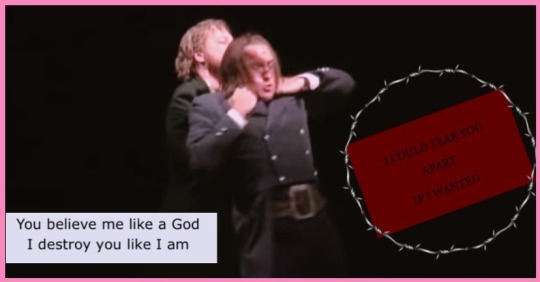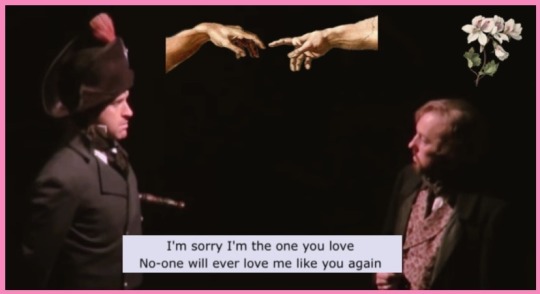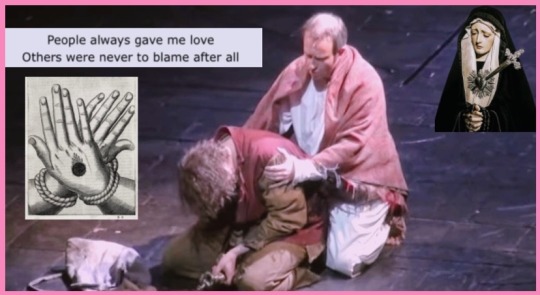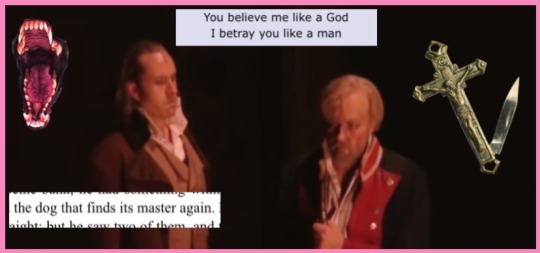#bishop myriel makes a guest appearance too
Explore tagged Tumblr posts
Text








the theme for @valvertweek, “between dog and wolf” immediately made me want to do something with the song “i’m your man” by mitski. so i put together some collages with the lyrics and some brick quotes.
caps are from a west end bootleg featuring earl carpenter as javert and john owen-jones as jean valjean
#this song is just. so them#les mis#valvert#valvert week#jean valjean#javert#bishop myriel makes a guest appearance too#earl carpenter#john owen-jones
83 notes
·
View notes
Text
Los miserables, 1971 – “Holy Hugo, they included ‘insert rare scene here’!”
Wrote this a while ago and realised I never posted it. So here goes.
Do you have a favourite obscure scene or detail in Les misérables that hardly ever makes the cut in screen adaptations? If you do, this might just be the adaptation for you. If you want to see an adaptation that tells the story well, however, this is not for you.
It's a nineteen-part (coincidence? I think not...) TV adaptation by the Spanish channel RTVE within its show “Novela”, a show of multiple literature adaptations that ran for fifteen years in total!
And the best part: You can see it all online on RTVE's webpage: http://www.rtve.es/alacarta/videos/los-miserables/
You can skip all episodes with mod 5 = 1 (except the first one), those are the episodes originally shown on Mondays, recapping what happened last week.
Like the Italian TV adaptation, this is unfortunately hindered by its budget. Unlike the Italian TV adaptation, this has the additional problem of its screenwriter's frankly bizarre understanding of concepts such as “pacing” and “importance”.
Now, don't get me wrong, I think it's rather cool to have an adaptation that includes many of the more obscure scenes, but I know the book and I know the context for all of these. I think asking how much sense the plot actually makes to someone who only knows this adaptation is a legitimate question.
Time is “wasted” on montages, dream-sequences and scenes of characters tossing and turning in bed, all of them many times longer than they have any right to be. Partially, it feels like the screenwriter couldn't decide which plot details to include and then just tried to incorporate as many of them as possible – continuity be damned. As an example, he took the time to include Mabeuf's death at the barricade, but it doesn't mean anything, since it happens to a character we have never seen before. Because Mabeuf's entire background is missing. To top it off, the watching students call him “le conventionel”, probably just to tick another box on the check list. To get another time saver, “show, don't tell” is occasionally blatantly violated. We get Valjean's entire history from him telling his life story to the bishop. The backstory of Marius and Gillenormand is conveyed in their fight before Marius leaves, meaning all the info is solely for the benefit of the audience, because all characters involved already know this stuff. Yet, bizarrely, they occasionally have time for a “show” where none would have been necessary. We get a far too long montage of Fantine with Cosette in Paris, that includes Fantine getting fired from her old job. Honestly, you can cover the question of why Fantine leaves Paris with a single line – you know, like it's done in the original?
I wouldn't usually mind, but it not only messes up the pacing, but it also takes up time that could have been used to flesh out some of the details. Or even some of the main plot points. We have Marius letting Thénardier go at the end, but Marius doesn't owe him a debt in this one. It might have made the Gorbeau robbery easier, but at the end, Marius has no real reason to not call the police. That is, if Thénardier is even a prison escapee. It's never shown nor mentioned how he got out of prison after the Gorbeau house robbery. On a smaller scale, it leads to a few bizarre moments, where introductions or transitions are missing, as if someone was trying to cut the corners wherever possible. For example, one episode starts with Marius' and Gillenormand's fight, without any introduction to their conflict or any real introduction of the characters (apart from Marius being the cute boy from the park). Or take the Champmathieu trial. The prosecutor asks for the witnesses to be heard and the very next moment, the judge is already questioning Brevet. No scene of the witnesses entering the room or at least the camera pointing out that they've been there all the time (because I definitely missed that in the overhead shots of the fairly small courtroom set); no scene of the judge calling the first witness, which becomes even worse when he does it to every subsequent witness.
Between this kind of overly short editing and long, drawn-out scenes of Marius healing (which commits the additional cardinal sin of making us think that it's finally over with a short conversation, only to continue for another minute or so) or of Fantine tossing on her bed (which we only later realise is prossibly Cosette's birth!), it feels a bit like there were too many people involved and no two of them could disagree over the tone and style of this adaptation.
I have another, if slightly petty, complaint: Why do the opening credits contain pictures of scenes we never get to see? It makes it pretty hard to identify which actor played which character and it also made it look they would include scenes that end up not being there. From the credits, you could be forgiven for thinking that there are scenes in Toulon, that Valjean's sister shows up or that they include the scene where Éponine stops Patron-Minette from robbing the house in the Rue Plumet. None of these actually happen.
Just to finish my list of complaints about this adaptation, let me talk about Javert. Now, I like the basic idea of what they did with the character, if only because it is the opposite to what most other adaptations do. In many adaptations, Javert is portrayed as a far more villainous character than in the book. These guys went the opposite way. Javert is calm and polite most of the time (making his one outburst when he arrests Valjean even more meaningful) and in one scene seems concerned about Fantine's safety (while she's still employed at Madeleine's factory that is), when he meets her in a disreputable part of town after dark and insists on accompanying her to her destination. Yes, it's later made clear that he still uses this to find out what she was doing there in the first place and this is what kicks off the chain of events leading to Mme Victurnien finding out about Cosette, but the two scenes taken together imply that Javert is both caring about the safety of an innocent civilian and spying on said civilian, just in case they're not as innocent as they seem to be. If they had done it like this throughout the movie I wouldn't be complaining.
Yet, it also means they had Javert come up to Madeleine, stating that he is happy to be the first to congratulate him about his appointment as mayor. It makes Javert's later resentment of Madeleine seem quite petty. Or the end of the “Confrontation”, where Javert, rather than leading Valjean out of the room, just makes a hand gesture to ask him to step out. Which again could have worked, but then he would have had to stay polite for all of the scene. Which he didn’t. They also decided not to stick to it for the entirety of the series. The portrayal of Javert in the later parts is more “traditional”, so to speak.
The acting is solid, for the most part, but hardly ever outstanding, although I’m likely not the best judge. Valjean's acting is fairly, occasionally too, subtle and he's a bit too calm for my taste in his entire encounter with the bishop. The actor, Pepe Calvo, is better known for his work in spaghetti western movies and I've by now realised that the reason he seemed familiar to me from the beginning is because of the western ��Dead Men Ride” which I saw as a child, in which he plays a Myriel-like character of all things. I've described my thoughts on Javert, but I think that is due to decisions by the director and the scriptwriter, not the actor. Fantine has an annoying tendency to overact, especially in the later parts of her appearance. Cosette, fortunately not played by the same actress, is a bit boring. Little Cosette, however, does outstanding work for a child actress. Both Thénardiers are decent; they went the ��Mme Thénardier needs to look sufficiently trustworthy for Fantine to leave her child with her”-route and she doesn't quite manage to be as scary as she should be. Everybody else is rather unremarkable.
Oh, and while we're at it: If you cast as Cosette an actress who actually looks like a teenager and as Marius an actor who might be in his early thirties, you need to specify that Marius is only a few years older than Cosette. Please!
But now to what I like about this adaptation: It's occasionally insane attention to details.
I've complained about the over-abundance of dream-sequences, but some of them really work. Showing one of Cosette's daydreams explains her life, character and dreams much better than any number of “real” scenes could have. Even more awesome is the inclusion of Valjean's dream before the Champmathieu trial. I mean, “Tempête sous un crâne” is usually going to be a weird scene anyway, you might just replace it with a weird dream while you're at it. Also, holy shit, they included Valjean's dream! That's a definite first.
Here's a list of further uncommon scenes this movie has: -Valjean steals Petit-Gervais's coin, although he does it before meeting the bishop -The bishop gets some exposition. It's only done in two conversations with his sister and Mme Magloire, but it's there -The scene of Tholomyès and Co. dumping the girls -A meeting of the Amis verbatim from the book -Gillenormand believes Marius to be dead and faints when Marius opens his eyes.
And here's a list of crazily uncommon scenes this movie has: -Fantine's meeting with the Thénardiers includes the girls using a cart chain as a swing -Details about work in the jet factory -Fantine thinks she hears Cosette outside the hospital -Cosette lying about watering the guest's horse -The coffin-escape! In full, glorious length and details. -Javert has a letter from the prefect in his pocket -Marius' note to identify his corpse -Escaping from the barricade in National Guard uniforms (although Valjean doesn't put in the one he is currently wearing) -Valjean writes the letter explaining to Cosette the origins of his fortune
Also, the ending is really well done. I really recommend you watch it for yourself, I don't think describing it can do it justice.
Generally, avoid this for a first look at Les Mis, but for a fan this is an interesting adaptation to watch and I suggest you give at least some parts a look, if only for the novelty.
33 notes
·
View notes